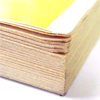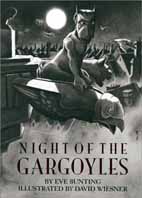|
|
|
|
|
|
|

| 최근 이 책을 구매하신 다른 회원의 책장 |
|
 |
|
|
|
[ 책 소개 ]
* A New York Times Best Book of the Year
* A School Library Journal Best Book of the Year
* An ABA "Pick of the Lists"
* A Parenting Magazine Reading Magic Award Book 수상작
* A Bank Street College Childdren's Book of the Year
"Flotsam," "Mr. Wuffles!," "Tuesday," "Sector 7," "Free Fall," "The Three Pigs" 등 무려 여섯차례나 Caldecott상을 수상한 이 시대 최고의 Illustrator중 한명인 David Wiesner가 목탄으로 그린 독특한 흑백의 그림책입니다.
큰 눈을 부릅뜨고 박물관 건물의 처마를 장식하는 괴물 석상들이 밤이 되자 모두 살아 움직입니다. 벽을 타고 내려가서 박물관 안의 이집트 미이라를 보기도 하는, 날개 달린 석상은 하늘로 날아 올라가기도 하며, 순찰을 도는 경비원을 놀래켜 주기도 합니다.... 날이 밝아 오면 이들은 언제 그랬냐는 듯 모두 제 자리로 돌아가 꼼짝하지 않고 하루를 맞이하지요.
큰 사이즈의 | 닫기x |  What is 페이퍼백? What is 페이퍼백?
표지가 두꺼운 판지나 보드지가 아닌 비교적 얇은 종이를 사용해서 만든 책이며, 실박음질 대신에 풀로 제본처리하는 경우가 많습니다. 일반적으로 하드커버나 보드북에 비해서 가격이 저렴합니다. 소프트커버로 불리우기도 합니다. 책의 이음새 부분이 접히거나 휘는 내구성이 그리 좋지는 않은 책입니다.
|
[ 관련 동영상 보기 ]
 ▶
[ 서지 정보 ]
Edition: Paperback, 32 pages
ISBN-10: 0395968879
ISBN-13: 9780395968871
책 크기: 28.4 cm x 20.4 cm
[ 영문 서평 ]
Book Description
In this stunning collaboration of two exceptional talents, the striking charcoal illustrations and nimble text reveal what happens at night when the gargoyles come to life.
Publisher's Weekly
In this haunting black-and-white picture book, Bunting and Wiesner (Tuesday) imagine the secret life of gargoyles. At night, while the city sleeps, they creep from their perches, clambering to the windows of the museum, where they ``peer,/ nearsighted,/ into rooms where mummies lie/ in boxes, long and thin/ as coffins, ribboned round/ with painted boats and figures.'' They then gather at the fountain to compare notes and thumb their noses at the night watchman before returning to their corners as day breaks. This is an unusually sophisticated work, playful but dark-edged. Its language is both economical and rich, its mood a complex blend of the eerie, the sensuous (the gargoyles ``lick the stars with long, stone tongues''), the innocent (the creatures evince a childlike curiosity and a touching, very human desire for company) and the melancholic (they ``have no love of humans who have made them so''). Wiesner captures all these moods and more in marvelously textured charcoal-powder illustrations that powerfully infuse the stone-solid watersprouts with life. The gargoyles' impish, grotesque grins-expressions just this side of malevolent-and ``empty eyes unblinking'' are not easily forgotten.
School Library Journal
What child hasn't looked at a sculpture or creatures carved in stone and wondered what would happen if they came to life? Bunting's canny phrasing and Wiesner's ominous black-and-white illustrations answer the question perfectly. When night comes, the gargoyles on a museum building come alive. They ``gargoyle-hunch'' with friends around a fountain, ``rumble-laugh'' at the night watchman, and resume their stone facades with empty eyes unblinking when morning arrives. If anyone could bring gargoyles to life pictorially, it's Wiesner. High-rise angles and perspectives are peopled with pigeons and squirrels; light is played against dark, forming menacing shadows; spreads and panels zoom in on narrow and wide-angle views; all creating a delicously eerie, spooky scenario. The brief text cunningly induces liveliness and wit with well-honed word choices: ``they grunt of what they've seen...they grump of summer passing...they boom those gargoyle laughs that rumble thick because there is no space inside their solid stone for laughs to somersault.'' This is not for very young children, but it's sure to have enormous appeal for older audiences. From stony-eyed stares to their merry scorn of humans, it's gargoyle gleefulness.
Booklist
In a macabre and funny picture book, those stone gargoyles that squat all day on public buildings get free at night and come down from their shadowy corners. Bunting's words are creepy and poetic, scary because they are so physically precise. The stone creatures are "pock-marked," their tongues "green-pickled at the edges." They have unblinking, bulging eyes and their mouths gape like empty suits of armor in museum halls. Wiesner's duotone charcoal illustrations capture the huge heaviness of the stone figures and their gloomy malevolence as they bump and fly and tumble free in the dark. They are so ugly. They're like fiends that come from the graves at night. They're also very human. Wiesner's funniest scene is a double-page spread of a group of gargoyle creatures hunching and grunting together at a spitting water fountain. They could be the gossips and grousers at your local neighborhood hangout. This book is more a situation than a story, but it makes you face what you've always feared but hadn't quite seen. Even the word gargoyle makes you choke.
Kirkus Reviews
At night a motley assortment of gargoyles come alive to ``creep on stubs of feet,'' to fly ``if they have gargoyle wings, straight up to lick the stars with long stone tongues,'' or to land in ``sleeping trees.'' But eventually they all gather at a fountain to ``gargoyle-hunch around the rim and gargoyle-grunt with friends from other corners who have come for company'' and complain all night long about the sun, the rain (which ``pours in torrents through their gaping lips and chokes their throats with autumn leaves'') and--of course--the ``humans who have made them so and set them high on ledges where dark pigeons go.'' These monsters, defined at the beginning of the book as waterspouts representing grotesque human or animal figures, come in a variety of forms--all surprisingly unsinister, despite Wiesner's gray palette. Somehow, these gargoyles appear stone-like and cuddly at the same time. Caldecott medalwinner Wiesner's charcoal drawings are as breathtaking as Bunting's prose in this wildly successful attempt to prove what we've always suspected: The gargoyle lives.
|
|
|
|
|
|
|
|
|